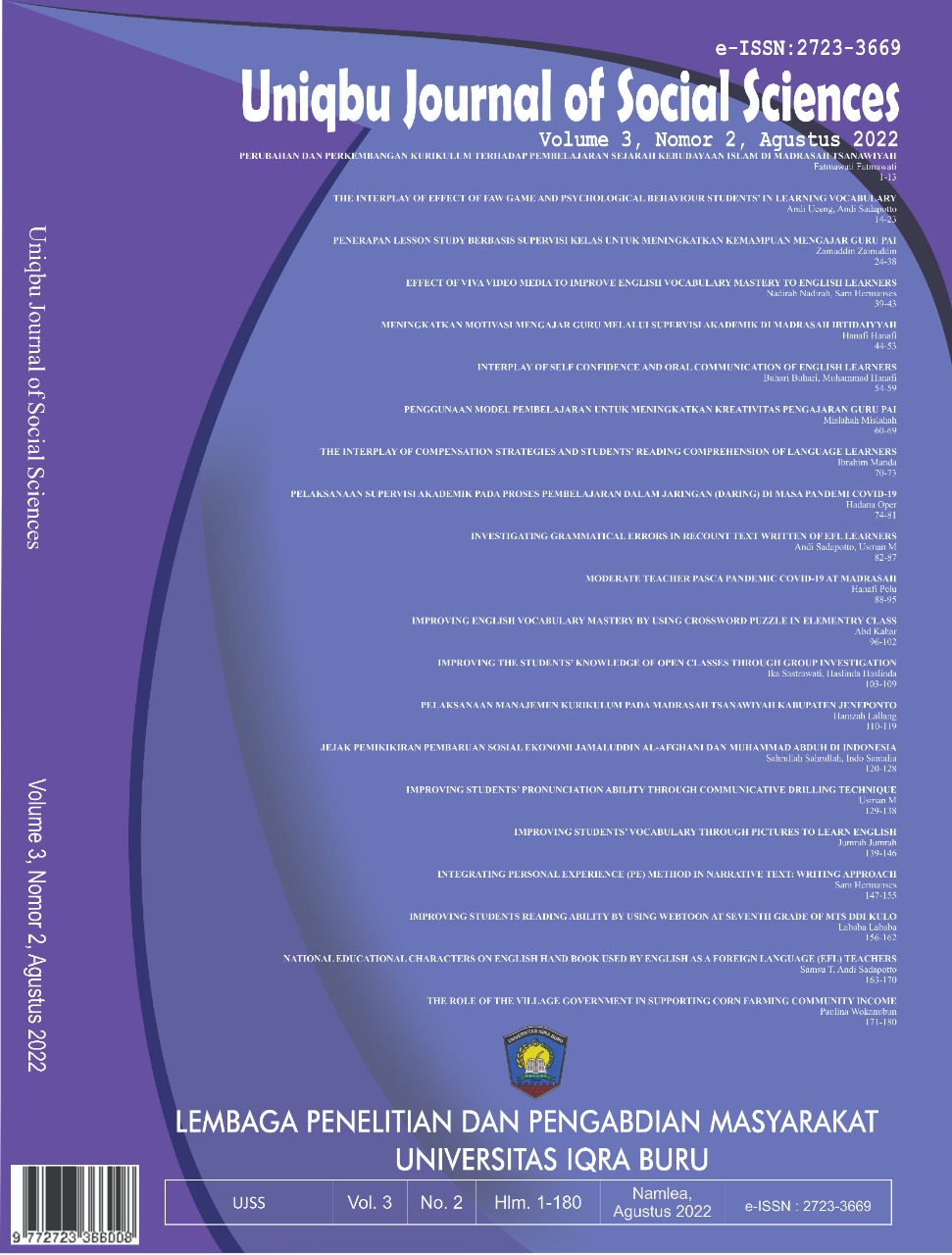INTEGRATING PERSONAL EXPERIENCE (PE) METHOD IN NARRATIVE TEXT: WRITING APPROACH
DOI:
https://doi.org/10.47323/ujss.v3i2.220Keywords:
Writing skills, narrative text, tense, students personal experience and vocabularyAbstract
The objective of this articles was to find out whether or not the use of students personal experience method improve writing ability of the eight grade students at SMP Negeri 3 Baranti. This research used pre-experimental method. The population of this research was three classes of the eight grade students at SMP Negeri 3 Baranti in academic year 2017/2018 with the total population were 61 students. The sample of this research was VIII. a (21 students). This sample was taken by simple random sampling technique. This research applied student personal experience (SPE) method. This research applied one kinds of instruments was writing test.The researcher found that by using student personal experience (SPE) method in teaching writing, it could improve the writing ability of the eight grade students at SMP Negeri 3 Baranti. It was proved by P-Value was lower than α (0,000<0,05). So, the researcher stated that H0 was rejected and H1 was accepted. Based on the data analysis, the researcher concluded that student personal experience (SPE) method was effective in improving students’ writing ability at SMP Negeri 3 Baranti.
References
Arikunto, Prajoko, 2008. Application of Quantum Writing Method toward Insya Subject at Madrasah Tsanawiyah Pabelan Magelang. On 2008 Digital Library UIN Sunan Kalijaga Yogyakarta.
Gunersel, et all. (2009) Improvement in Writing and Reviewing Skill with Calibrated Peer ReviewTM. International Journal for the Scholarship of Teaching and Learning.
Gay, L. R.,Geofrey E. Mills, Peter Airasian. 2006. Educational Research : Competences for analysis and Aplications - Eight Edition. Ohio : Pearson Merrill Prentice
Harmer, J. The practice of English Language Teaching, New York: Longman, 2007.
Hornby. A.S . 1995. Oxpord Advanced Learner’s Dictionary of Current English. Great Britain. Oxpord University Press. http://olc.spsd.sk.ca/De/PD/instr/storymapping/index.html accessed on 4 April 2014
J.B HeaLton. 1991. Writing English Language Tests. New edition. Longman handbooks Hall
Kagan.1994. An Introduction of Method to English Learning and Teaching”. England: Pearson Education Limited
Lado, Robert. 1988. Teaching English Across Cultures. Singapore: Kim Hup Lee Printing Co Pte Ltd
Nata, Aly (Online), 2018. Definition of Students Personal Experience. On 15 November 2017, 23.20 p.m.
Nikolov Marianne et.al. 2010. The relationship between reading skills in early English as a foreign language and Hungarian as a first language. International JouNrnikaol loofv B&ili nCgsuaapliós:m.
Rahman, Kaharuddin. 2015. Improving Writing Ability By Using Photograph at the Tenth Grade Students of SMA Negeri 1 Panca Rijang. S1. Unpublished : STKIP Muhammadiyah Sidrap.
Sarwar1 Muhammad et. Al. 2014. Assessing English speaking skills of Prospective Teachers at entry and graduation level in teacher Education program. language testing in Asia.
Shaarawy1Hanaa Youssef,. 2014 The Effect of Journal Writing on Students’ Cognitive Critical Thinking Skills. A Quasi-Experimental Research on an English as a Foreign
Sinaga et al, 2015. The Effectiveness of Scaffolding Design in Training Writing Skills Physics Teaching Materials. International Journal of Instruction.
Sugiyono, 2010.MetodePenelitianPendidikan: Pendekatan Kuantitatif, Kualitatif, dan R & D, Bandung: Alfabeta.
Yigzaw Abiy. 2013. High School Students’ Writing Skills and their English Language Proficiency as Predictors of their English Language Writing Performance. international journal.



